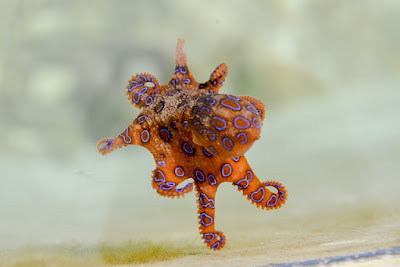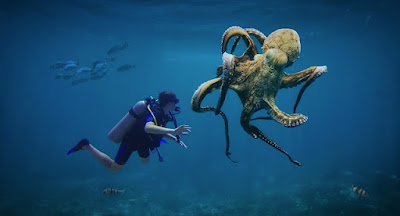Beneath the waves of the world's oceans lies a realm of remarkable creatures, each with their own unique set of adaptations and behavior. Among these marine wonders, the octopus stands out as a symbol of both mystery and intelligence. With their complex anatomy, advanced problem-solving abilities, and remarkable feats of camouflage, the octopus is a captivating subject of scientific study and admiration. In this article, we delve into the mysterious world of the octopus, exploring its anatomy, behavior and the fascinating ways it has captured the human imagination.
Anatomy of octopus
Octopuses are cephalopods, a group of mollusks that also includes squid and cuttlefish. The anatomy of these creatures is highly developed and sophisticated, suitable for their marine lifestyle. Key features of the octopus's anatomy include:
- Tentacles: Octopuses have eight long, flexible tentacles lined with suckers. These tentacles are incredibly dexterous, allowing the octopus to manipulate objects, capture prey, and explore its environment.
- Beak: Located in the center of its tentacles, an octopus has a sharp, parrot-like beak that is used to tear apart prey.
- Three hearts: Octopuses have three hearts: two branchial hearts and one systemic heart. The branchial heart pumps blood through the gills for oxygen, while the systemic heart circulates oxygenated blood throughout the body.
- Highly developed eyes: Octopuses have sophisticated eyes that resemble those of vertebrates. Their keen vision helps them locate prey and predators even in low light conditions.
- Ability to change color: Octopuses are famous for their ability to rapidly change color and texture, thanks to special pigment cells called chromatophores and muscle skin. They use this skill for communication, camouflage and hunting.
- Cephalopod Ink: Octopuses can release a cloud of ink to create a curtain of smoke to confuse and avoid predators. The ink is a mixture of melanin and mucus.
Behavior and intelligence
Octopuses are known for their extraordinary intelligence, making them one of the most interesting creatures in the animal kingdom. Here are some notable aspects of octopus behavior and intelligence:
- Problem Solving: Octopuses have demonstrated impressive problem-solving abilities in laboratory experiments. They can open jars, navigate mazes and solve complex puzzles, demonstrating their advanced cognitive skills.
- Tool Use: Some octopus species have been observed using tools such as coconut shells to build shelter or as shields for protection.
- Camouflage: Octopuses are adept at camouflage, able to blend in seamlessly with their surroundings by changing the color, texture, and pattern of their skin. This remarkable ability helps them both to hunt and to hide from predators.
- Communication: Octopuses communicate with each other using a variety of signals, including color changes, body postures, and even tactile interactions. They can communicate information to other octopuses about their moods, intentions and warnings.
- Complex social behavior: While octopuses are generally solitary animals, they display complex social behavior during mating and during interactions with conspecifics (members of the same species).
- Short Lifespan: Most octopus species have a relatively short lifespan, typically one to five years. This limited lifespan may contribute to their rapid learning and adaptability.
Cultural significance
Octopuses have played an important role in various cultures and mythologies throughout history. He has been depicted in literature, art and folklore as a symbol of wisdom, transformation and mystery. In many coastal communities, octopuses are a valuable food source and have culinary traditions associated with them.
The octopus is an amazing creature that continues to captivate our imaginations with its intelligence, adaptability and extraordinary abilities. As scientists continue to study and uncover the secrets of these mysterious cephalopods, we gain a deeper appreciation for the complexity and diversity of life in the world's oceans. Octopuses remind us of the immense wonders that lie beneath the surface of our planet and the importance of preserving and protecting these ecosystems for future generations to wonder and study.
Here are some interesting octopus facts:
- Advanced Cephalopods: Octopuses belong to the cephalopod class, which also includes squid, cuttlefish, and nautiluses. They are considered the most intelligent among cephalopods.
- Eight arms: Octopuses have eight arms, lined with suckers that help them grasp objects, manipulate prey, and navigate their environment. These arms are incredibly flexible and dexterous.
- Nocturnal hunters: Many octopus species are nocturnal, meaning they are active primarily at night. Their keen night vision helps them hunt in the dark.
- Camouflage Masters: Octopuses are renowned for their ability to change color, texture, and pattern with astonishing speed and accuracy. They use this skill for camouflage, communication and hunting.
- Chromatophores: The ability to change color is facilitated by specialized pigment cells called chromatophores, which expand and contract to produce different colors and patterns on the octopus's skin.
- Ink defense: When threatened by predators, octopuses can release a cloud of ink, creating a smokescreen that confuses their attackers and provides an opportunity for escape.
- Solitary creatures: Most octopus species are solitary and do not form long-term social bonds. They live independent lives and often avoid contact with other octopuses except to mate.
- Cognitive abilities: Octopuses have shown remarkable problem-solving abilities in laboratory experiments. They can open jars, solve mazes, and exhibit learning behavior.
- Escape Artists: Octopuses are notorious for their escape abilities. They can fit into small holes and have been known to slip out of aquarium tanks, making them challenging to keep in captivity.
- Short Lifespan: Octopuses usually have a relatively short lifespan, often ranging from one to five years. Their rapid growth, reproduction, and short life cycle contribute to their adaptability.
- Complex nervous system: Octopuses have a highly developed nervous system, with most of the neurons located in their arms. This decentralized nervous system allows their arms to function semi-independently.
- Poisonous Bite: While octopuses are generally not dangerous to humans, some species have a poisonous bite. Their beak, located in the center of their arms, is used to pierce the shells of crustacean prey.
- Jet Propulsion: Octopuses are capable of jet propulsion, expelling water from a siphon to move rapidly through the ocean. They can also use this technique to run away faster.
- Masters of Mimicry: Some octopus species, such as the mimic octopus and wonderpus, are known for their ability to mimic other sea creatures, such as lionfish, flatfish, and sea snakes, as a form of camouflage and protection.
- Diverse Diet: Octopuses are opportunistic feeders and have a diverse diet that includes crustaceans, fish, mollusks, and even other octopuses.
- Remarkable vision: Octopuses have well-developed eyes with complex retinas, which allow them to see a wide range of colors and shapes. Their vision is important for detecting prey and predators.




Comments
Post a Comment